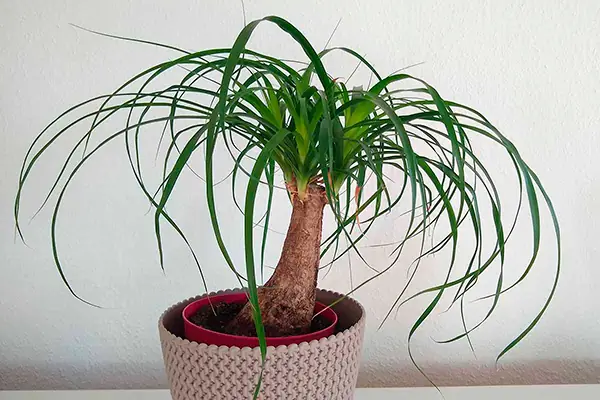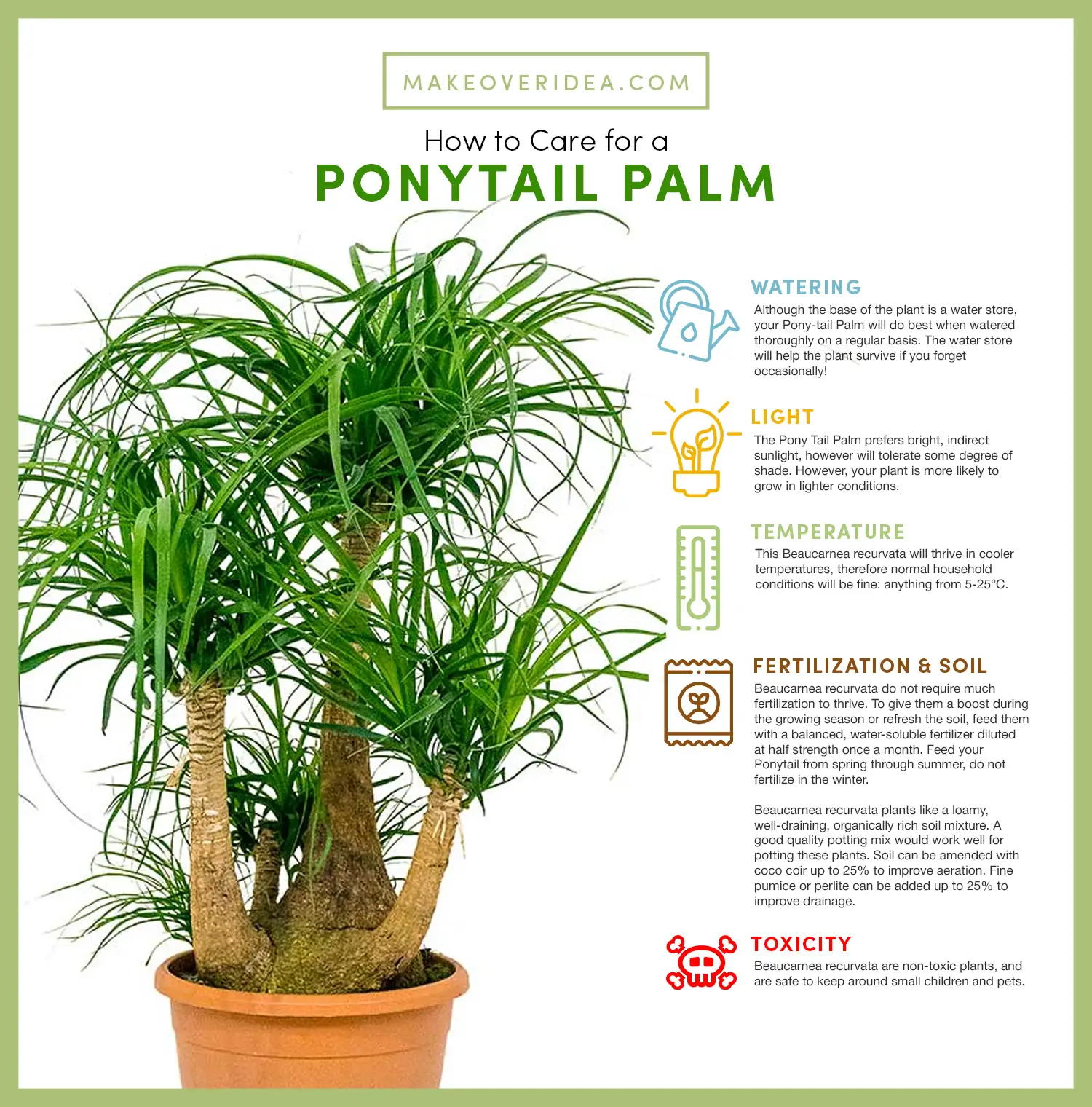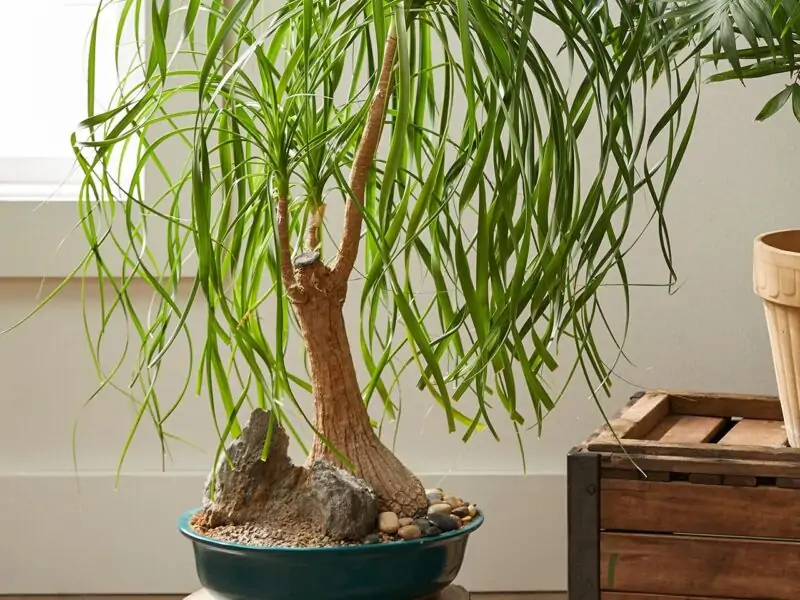Ponytail Palm Dying: Unraveling the Causes and Solutions for Brown and Crispy Leaves

Is your ponytail palm dying? Don’t despair! With a clear understanding of the issues and solutions, you can restore its health. This article will address the common causes and remedies for a ponytail palm dying.
Introduction
Getting to Know the Ponytail Palm
Before we dive into how to revive your dying ponytail plant, let’s first understand its characteristics. This unique tropical plant also known as Beaucarnea recurvata hails from Mexico. Today, it’s grown worldwide because it’s easy to care for. The thick trunk of the ponytail palm, similar to an elephant foot or a bottle, stores water. This allows the plant to survive during droughts.
The ponytail palm grows slowly and has long green leaves that arch from the top. They look like cascading hair, which is why it’s called a “ponytail” palm. Its exotic look makes it an excellent choice for a houseplant or garden decoration.
The Importance of Proper Ponytail Palm Care
To keep your ponytail palm thriving indoors, you need to know what makes it happy. This includes plenty of bright light, but not direct sunlight. The plant needs well-draining soil mixed with sand for good drainage. Water your plant only when the soil is completely dry up to 2 inches deep. There’s a lot more to know!
Proper care ensures healthy growth patterns. It maintains the brownish-green hues of the plant and prevents yellow leaves. The latter is often a result of dehydration or overwatering. These are common issues among new plant owners who are still learning how to care for this delicate species.
Why is Your Ponytail Palm Dying?
Is your ponytail palm dying? If so, it can be distressing. These tropical plants are known for their resilience. But they still need proper care to thrive. There could be several reasons why your ponytail palm is showing signs of distress.

Dehydration: How Much Water Does a Ponytail Palm Need?
Dehydration is one typical explanation. Underwatering or irregular irrigation might cause this. These succulent-like plants require some water even though they don’t require a lot. So how much water is required by a ponytail palm? Before watering, allow the soil to totally dry out. Then soak it thoroughly. Continue until the drainage holes in the pot are clear of extra water. The humidity levels in your home and the season will affect how often you water. Watering should usually be sufficient once every two weeks.
Overwatering: The Problem of Root Rot and Stem Rot
Overwatering can also harm your ponytail palm. It can lead to root rot, which affects the plant’s ability to absorb nutrients. Root rot turns the roots mushy and brown. Stem rot can cause irreversible damage. This can lead to the death of the plant if not treated quickly. This is especially true in winter when growth slows down. Make sure to drain the water from the pots using saucers.
Excess water can occur if the soil doesn’t drain well. Ponytail palms prefer well-draining soils. This allows the water to evaporate. Avoid overwatering, especially in hot summer periods. During these periods, the plant may need more water than usual.
Underwatering: Risks of Neglecting Water Needs
On the other hand, if you neglect to water your ponytail palm, it may dry out. This can cause the leaves to turn yellow and crispy. When this happens, water your plant until the soil is moist. You can also add organic matter like peat moss. This helps the soil retain moisture for longer periods.
Pest Attacks: The Mealybug Threat
Pests can also cause a ponytail palm to die. Mealybugs are a common pest. They suck sap from the leaves. This causes the leaves to turn yellow and fall off. This can slow the growth rate of the plant, especially in young plants. To prevent infestations, avoid over-fertilizing. High levels of nitrogen and phosphorus can attract pests. You can use natural alternatives like neem oil mixed with dish soap. Spray this directly onto the infected areas.
Fertilizer Issues: Overuse and Deficiency
Fertilizer-related problems can also harm your ponytail palm. This includes nutrient deficiency or excess use. This can lead to leaf loss or stem rot. Synthetic fertilizers can harm the environment. Instead, use eco-friendly solutions. Soil testing kits are available at most garden supply centers. They can help you improve soil quality.
The Wrong Type of Soil: Drainage and Nutrient Content
Ponytail palms require lots of light. However, the sun’s rays can harm their leaves. Set up your plant close to a window. It need to receive some soft natural light. This encourages robust growth.
Environmental Stressors: Low Temperature and Poor Light Conditions
Lastly, environmental stressors can harm your ponytail palm. This includes low temperatures and poor light conditions. These can turn its leaves yellow and crispy. They can even cause the leaves to fall off. Place your plant near a window that gets sunlight. Avoid placing it near radiators or air conditioning vents. These can dry out the plant and cause dehydration.
How to Revive a Dying Ponytail Palm?
Your ponytail palm looks sad. It’s dying, but don’t lose hope! You can revive it. Let’s learn how.
Addressing Overwatering and Root Rot
Overwatering is a common cause of a ponytail palm dying. This leads to root rot. It’s a serious problem that can kill the plant.
- First, remove the plant from its pot.
- Check the roots. Look for mushy roots or discoloration. These are signs of root rot.
- Cut away all damaged parts. Use sterile pruning shears. Keep only healthy white roots.
- Let the remaining dirt dry after that. Wait for at least a day. As a result, extra moisture can evaporate.
- Repot your plant after that. Make use of new potting soil. This mixture ought to work well with succulent plants like ponytail palms. It’s best to combine sandy loam with perlite or grit.
- Ensure that the plant pot has drainage holes. This prevents water from collecting at the base of the plant. Over time, this can damage the plant.
Correcting Under-watering and Dehydration
Under-watered plants show signs of dehydration. Leaves turn brown and crispy. There may be yellowish-brown spots on the leaves.
To fix this, check your watering routine. Ensure you’re giving your plant enough water. But don’t overwater! You can check soil moisture with your finger. Water your plant when the top 1-2 inches of soil is dry.
Dealing With Pests Like Mealybugs
Pests like mealybugs can attack your plant. They suck the sap from the leaves. This can cause the leaves to turn yellow.
You can use insecticidal soap sprays or neem oil. Apply these to infested areas. This kills the pests. You can also use rubbing alcohol and cotton swabs. Wipe down all the affected areas.
Fixing Fertilizer Related Problems
Using too much or too little fertilizer can harm your plant. It can lead to yellowing or browning leaves. It can also weaken the plant.
The key is balance. Follow the directions on the fertilizer packaging. Also, consider factors like soil pH and sunlight.
Choosing The Right Soil For Your Ponytail Palm
The right soil is crucial for your ponytail palm. The plant prefers a well-draining soil. This prevents root rot. A sandy loam mixed with perlite or grit is a good choice.
When you repot your plant, make sure the pot has drainage holes. This prevents water from building up around the roots.
Adjusting Environmental Factors For Optimal Growth
Ponytail palms need bright light. But, direct sunlight can damage their leaves. Place your plant near a window. It should get indirect natural light. This promotes healthy growth.
In summary, reviving a dying ponytail palm involves proper watering, pest control, and fertilizer use. Also, choose the right soil and location for your plant. With these steps, you can bring your ponytail palm back to life.
Frequently Asked Questions

If your ponytail palm is dying, don’t worry. There’s still hope! Let’s address some common questions about reviving a struggling ponytail palm.
When your ponytail palm outgrows its pot, it’s time to repot. Start with a new pot. It should be 2-4 inches wider than the old one. Get a well-draining soil mix ready for it.
Carefully remove the plant from its old pot. Check the roots. If they’re tangled, loosen them gently. Then put the plant in the new pot. Add more soil around the root ball. Press down firmly, but not too hard. Finish by giving it a good water.
Ponytail palms come from dry climates. They can handle drought better than too much water. So, be careful with watering.
In spring through fall, let the top inch or two of soil dry out between waterings. In colder weather, when it’s below 50°F (10°C), water less. The plant will rest until the weather warms up.
Yes, you can! If you spot mealybugs early, you can remove them. Use cotton swabs dipped in diluted alcohol. Or try a spray of insecticidal soap.
For a big bug problem, consider using neem oil. Apply it to the areas where pests are attacking the plant.
The time it takes depends on the damage. Some cases might need weeks. Others could take months.
You’ll need to change some things. Adjust the temperature, light, and airflow. Fertilize regularly. And keep an eye on the plant. Look for yellow, brown, or droopy leaves.
Signs of stress can be yellow or brown leaves. Or droopy stems and leaves. The plant might not grow as much. Or it may have fewer flowers.
Stress can be caused by too much or too little water. Bugs can also cause stress. They suck the sap from the plant. This can lead to a problem called chlorosis.
Conclusion
A dying Beaucarnea Recurvata can be saved. Often, the problem is caused by the environment. Bad light or low temperatures can hurt the plant. But overwatering or underwatering can too.
To take good care of your palm, make sure it has good drainage. Use the right soil. And water it the right way. Regular fertilization will help too. And make sure it has bright, indirect sunlight.
By doing these things, you can bring your dying ponytail palm back to life!